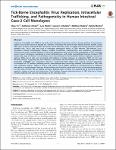Tick-Borne Encephalitis Virus Replication, Intracellular Trafficking, and Pathogenicity in Human Intestinal Caco-2 Cell Monolayers
Yu, Chao
Achazi, Katharina
Möller, Lars
Schulzke, Jörg D.
Niedrig, Matthias
Bücker, Roland
Tick-borne encephalitis virus (TBEV) is one of the most important vector-borne viruses in Europe and Asia. Its transmission mainly occurs by the bite of an infected tick. However, consuming milk products from infected livestock animals caused TBEV cases. To better understand TBEV transmission via the alimentary route, we studied viral infection of human intestinal epithelial cells. Caco-2 cells were used to investigate pathological effects of TBEV infection. TBEV-infected Caco-2 monolayers showed morphological changes including cytoskeleton rearrangements and cytoplasmic vacuolization. Ultrastructural analysis revealed dilatation of the rough endoplasmic reticulum and further enlargement to TBEV containing caverns. Caco-2 monolayers maintained an intact epithelial barrier with stable transepithelial electrical resistance (TER) during early stage of infection. Concomitantly, viruses were detected in the basolateral medium, implying a transcytosis pathway. When Caco-2 cells were pre-treated with inhibitors of cellular pathways of endocytosis TBEV cell entry was efficiently blocked, suggesting that actin filaments (Cytochalasin) and microtubules (Nocodazole) are important for PI3K-dependent (LY294002) virus endocytosis. Moreover, experimental fluid uptake assay showed increased intracellular accumulation of FITC-dextran containing vesicles. Immunofluorescence microscopy revealed co-localization of TBEV with early endosome antigen-1 (EEA1) as well as with sorting nexin-5 (SNX5), pointing to macropinocytosis as trafficking mechanism. In the late phase of infection, further evidence was found for translocation of virus via the paracellular pathway. Five days after infection TER was slightly decreased. Epithelial barrier integrity was impaired due to increased epithelial apoptosis, leading to passive viral translocation. These findings illuminate pathomechanisms in TBEV infection of human intestinal epithelial cells and viral transmission via the alimentary route.
No license information
Related Items
Show related Items with similar Title, Author, Creator or Subject.
-
2000-10-01ZeitschriftenartikelLebensmittelassoziierte Virusinfektionen Höhne, Marina; Schreier, EckartBis in die 70er Jahre war die Diagnostik von infektiösen Diarrhöen auf den Nachweis von Bakterien und Parasiten beschränkt, und auslösende Erreger konnten nur in einigen Fällen ermittelt werden. Verbesserte Nachweismethoden ...
-
2015-06-19ZeitschriftenartikelIn Silico Prediction and Experimental Confirmation of HA Residues Conferring Enhanced Human Receptor Specificity of H5N1 Influenza A Viruses Schmier, Sonja; Mostafa, Ahmed; Haarmann, Thomas; Bannert, Norbert; Ziebuhr, John; Veljkovic, Veljko; Dietrich, Ursula; Pleschka, StephanNewly emerging influenza A viruses (IAV) pose a major threat to human health by causing seasonal epidemics and/or pandemics, the latter often facilitated by the lack of pre-existing immunity in the general population. Early ...
-
2015-11-10ZeitschriftenartikelComparison of the Cowpox Virus and Vaccinia Virus Mature Virion Proteome: Analysis of the Species- and Strain-Specific Proteome Döllinger, Jörg; Schaade, Lars; Nitsche, AndreasCowpox virus (CPXV) causes most zoonotic orthopoxvirus (OPV) infections in Europe and Northern as well as Central Asia. The virus has the broadest host range of OPV and is transmitted to humans from rodents and other wild ...

